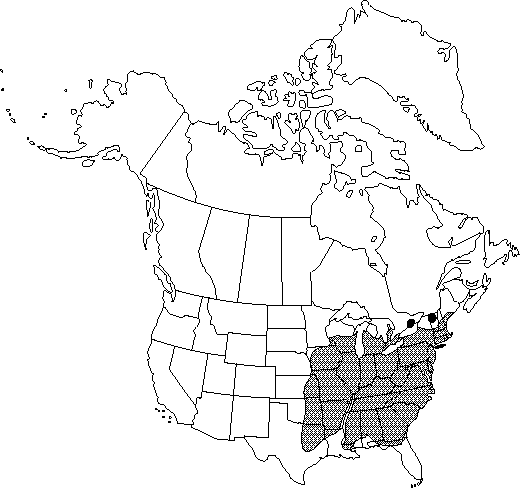Quercus velutina
in J. Lamarck et al., Encycl. 1: 721. 1785.
Trees, deciduous, to 25 m. Bark dark-brown to black, deeply furrowed, ridges often broken into irregular blocks, inner bark yellow or orange. Twigs dark reddish-brown, (1.5-) 2.5-4.5 (-5) mm diam., glabrous or sparsely pubescent. Terminal buds ovoid or ellipsoid to subconic, 6-12 mm, noticeably 5-angled in cross-section, tawny or gray-pubescent. Leaves: petiole 25-70 mm, glabrous to sparsely pubescent. Leaf-blade ovate to obovate, (80-) 100-300 × 80-150 mm, base obtuse to truncate, inequilateral, margins with 5-9 lobes and 15-50 awns, lobes oblong or distally expanded, separated by deep sinuses, apex acute to obtuse; surfaces abaxially pale green, glabrous except for small axillary tufts of tomentum or with scattered pubescence, especially along veins, adaxially glossy, dark green, glabrous, secondary-veins raised on both surfaces. Acorns biennial; cup cupshaped or turbinate, 7-14 mm high × 12-22 mm wide, covering 1/2 nut, cup margins not involute, outer surface puberulent, inner surface pubescent, scale tips loose, especially at margin of cup, acute to acuminate; nut subglobose to ovoid, 10-20 × 10-18 mm, glabrate, scar diam. 5.5-12 mm. n = 12 ± 1; 2n = 24.
Phenology: Flowering spring.
Habitat: Commonly on dry slopes and upland areas, occasionally on sandy lowlands (especially in north) and poorly drained uplands and terraces
Elevation: 0-1500 m
Distribution

Ont., Ala., Ark., Conn., Del., D.C., Fla., Ga., Ill., Ind., Iowa, Kans., Ky., La., Maine, Md., Mass., Mich., Minn., Miss., Mo., Nebr., N.H., N.J., N.Y., N.C., Ohio, Okla., Pa., R.I., S.C., Tenn., Tex., Vt., Va., W.Va., Wis.
Discussion
The bark of this species (quercitron) is rich in tannins and was once an important source of these chemicals used for tanning leather. (The yellow dye obtained from the bark is also called quercitron.)
Native Americans used Quercus velutina medicinally for indigestion, chronic dysentery, mouth sores, chills and fevers, chapped skin, hoarseness, milky urine, lung trouble, sore eyes, and as a tonic, an antiseptic, and an emetic (D. E. Moerman 1986).
Quercus velutina reportedly hybridizes with Q. coccinea, Q. ellipsoidalis (= Q. ×paleolithicola Trelease), Q. falcata [= Q. ×willdenowiana (Dippel) Zabel] (= Q. ×pinetorum Moldenke)], Q. ilicifolia (= Q. ×rehderi Trelease), Q. imbricaria (= Q. ×leana Nuttall), Q. incana, Q. laevis, and Q. laurifolia (= Q. ×cocksii Sargent, although E. J. Palmer [1948] challenged the validity of this claim), Q. marilandica, Q. nigra, Q. palustris (= Q. ×vaga E. J. Palmer & Steyermark), Q. phellos (= Q. ×filialis Little), Q. rubra, Q. shumardii, and possibly Q. arkansana (D. M. Hunt 1989).
Selected References
None.
